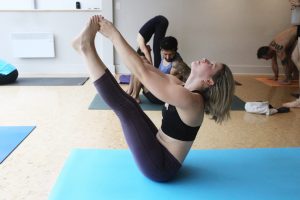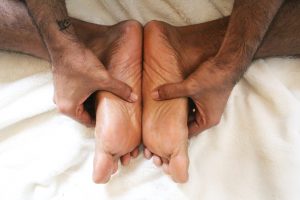I have started doing something that has seriously changed the game for my practice, and my life – daily self-massage or Abhyanga as it is called in Ayurveda.
Abhyanga is the Ayurvedic ritual of massaging your entire body using oil. It promotes lymphatic drainage, helps to balance your Dosha and creates soft supple skin… but I would also like to make the case that it can support your practice too.
So at first, I was wary of doing Abhyanga in the morning before practice because well.. you get oily. It would obviously make you more slippery which would make certain asanas more difficult. But after doing this for some time now I’ve realized that for me it’s the opposite.
It’s actually IMPROVED my ability to perform asana, and may even be linked to better recovery and a host of other health benefits.

So here’s how Abhyanga can help your practice:
-
It helps keep the joints healthy
When we perform abhyanga daily, we massage not only the limbs and muscles, but we make circular motions around the joint. This not only increases our proprioception in that area but stimulates blood flow and may reduce pain or discomfort in the joint during practice.
I’ve noticed on days that I do abhyanga my knees (which sometimes feel uncomfortable due to my tight hips) feel way better. Getting into lotus feels smoother and more natural.
“The body of one who uses oil massage regularly does not become affected much even if subjected to accidental injuries, or strenuous work. By using oil massage daily, a person is endowed with pleasant touch, trimmed body parts and becomes strong, charming and least affected by old age.” – Charaka Samhita Vol. 1 V 88-89
-
It improves lymphatic drainage and helps with detoxification
When we practice asana, we are detoxifying our body in many ways. We’re sweating, we’re twisting in ways that support the cleansing of our digestive tract, and many asanas help with lymphatic drainage.
But if you really want to up your lymphatic drainage game, abhyanga is key. You literally move the lymph around, and help it with the detoxification process. Lymph is on of the main tissues responsible for detoxification, and so ensuring it is moving properly is important if we want to stay healthy and strong for our life and our practice.
-
Creates new neural connections
There’s this concept in neurophysiology that you “use it or lose it.” Our brain likes to focus on, and enhance neural connections to the areas of the body, and the movements that we use and connect with most often. But, for optimal health and well-being, we want to stimulate neural connections all over the body.
When we do abhyanga, we stimulate different area’s of the brain, and remind it of parts of the body that we may not access daily in our Sadhana. This helps increase proprioceptive awareness, and may lead to positive shifts in our asana practice!
-
Creates deep connection to ourselves and has a grounding quality
When we do asana, we connect with our body and our breath in a way that’s really beautiful. And I personally believe that abhyanga is another great way to connect with the body.
The term Sneha can be translated to both oil and love. Abhyanga is seen as a form of self-love in Ayurveda and deep connection to our physical body. This practice is challenging, and often brings up difficult emotions and can make us feel “out of whack” sometimes. And maybe, we can be hard on ourselves physically and emotionally.
I think Abhyanga is a great way to show ourselves some love as daily practitioners, and to help us stay grounded on this often time tumultuous journey of Ashtanga Yoga.

So how do we do Abhyanga?
It’s simple, let me walk you through it:
- Pick your oil of your choice – coconut, sesame, or a Dosha specific oil if you’re feeling fancy. Traditionally you would warm the oil by placing the jar in some warm water, but if that takes too long, it’s fine to work with what you’ve got.
- Adopt a calm, loving, sattvic mindset toward yourself as you begin.
- Being by massaging your head – start at the crown, and slowly massage the entire head. Then make your way to the face, the temples, the ears, and the throat and back of the neck.
- Work your way down to the shoulders, chest, neck and upper back.
- Make your way to the limbs. Note: when you massage the limbs, use long stroking motions, and when massaging around the joints use a circular motion.
- When massaging the stomach, we want to massage in the direction of digestion – and work in a clockwise manner.
- Now, begin massaging the legs – from the tops of the feet, up to the hip creases, using long strokes around the limbs, and circular motion around the joints.
- Finish off the massage by massaging the feet – we have lots of nerve endings in the feet, and several Marma points, so we want to spend some time here.
- Try sitting with the oil for several minutes if possible – sometimes I do this before practice! (Tip: You don’t need to use so much oil that you’re like soaked. Just a little to moisturize the body, we’re not trying to become a human slip and slide!)
- Once you’ve showered, pat your body dry rather than scrubbing it – this will help keep your body lubricated and feeling great!
Now, you don’t need to do abhyanga every single day – a few times a week is sufficient. I will say that I do it most days, and notice a difference in mood, my physical practice and my overall feeling of “groundedness” (if that’s even word) and connection to myself when I do.
I hope you found this article helpful.
If you try this out let us know how it goes! You can either comment below, or share with us on instagram @ashtangatoronto. We’d love to hear how it’s helped your practice.
And if you’re in the Toronto area, or will be soon, take a look at our schedule and upcoming workshops to see if you can join us!
